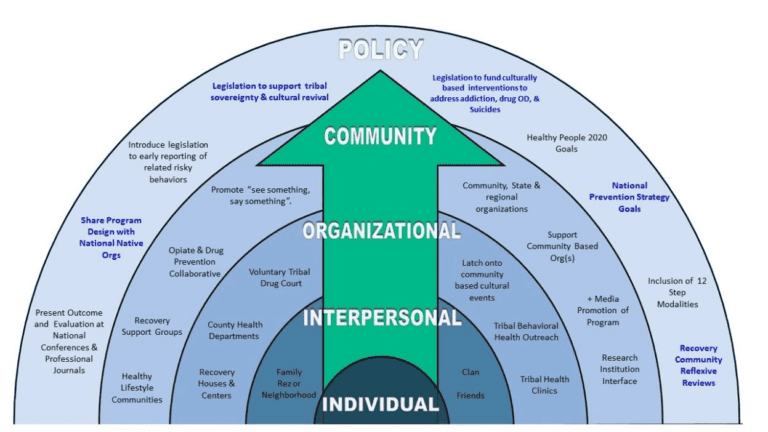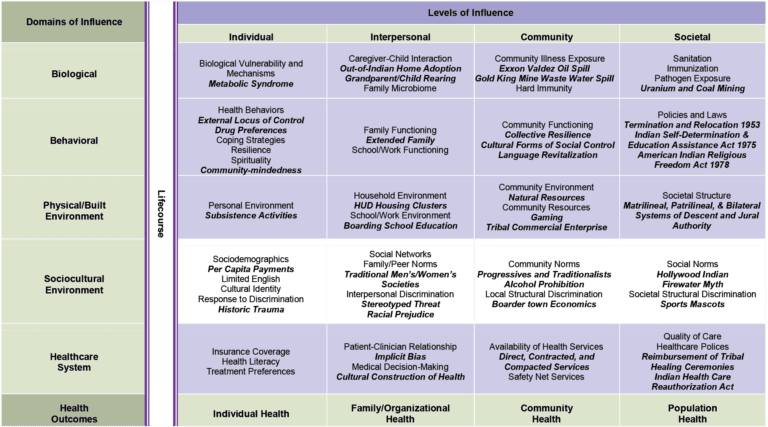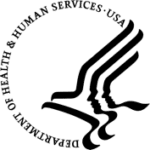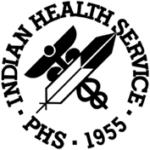Appendix
Tribal Coordination of Healing
Although AI/AN communities face a daunting combination of historical and intergenerational trauma, cultural discontinuity, oppressive federal Indian policy, and the systemic issues resulting, they continue to thrive. The next step, however, is to move from understanding the context and challenge of this historical legacy and helping Native communities heal.
The CDC has offered some guidance by using social-ecological modeling to identify potential reforms at the individual, family, community, tribal, and societal levels. Below is one such model, designed to address substance-use disorders and suicide in the context of intergenerational trauma.

Figure 17. Examples of how to confront historical and intergenerational trauma (Melnick)
Structuring interventions across multiple levels could more effectively confront substance-use disorders in general, in addition to giving Native communities powerful new tools to fight the opioid epidemic. It is important to keep in mind however, given the traditional interdependence of tribal communities, these social dimensions are often blurred—a tribe is both a community and an organization, for example, and so multiple categories of intervention may apply. While complex, these holistic solutions are crucial to successful implementation of any intervention strategy. Figure 18 illustrates some of the complex ways that influence can operate in Native communities. (Alvidrez et al., 2019).

Figure 18. Levels of influence and their domains
Considering these factors, individually and in combination, is crucial to developing holistic, trauma-informed strategies. While certain broad patterns exist among AI/AN communities— cultural identity, manifestations of historical trauma, sociocultural attitudes toward drug and alcohol use, and the like—the tool can be applied to particular tribes, communities, or regions to provide a clearer view of the specific challenges they face. This helps ensure an individualized, culturally appropriate fit between a strategy and the issue it aims to address. This sort of approach has led to more traditional, trauma-informed health approaches on the part of the federal government, state health agencies, and regional tribal organizations. While not all tribal leaders or policymakers are expected to be experts in trauma-informed care, a baseline competence on the subject is helpful in treating AI/AN communities with compassion, empathy, and understanding.
Definitions
American Indian and Alaska Native (AI/AN): the Indigenous people of what is now known as the contiguous United States and Alaska.
Boarding Schools: residential educational facilities intended to force Western education upon the AI/AN people while also attempting cultural erasure and assimilation.
Bureau of Indian Affairs (BIA): the branch of the U.S. Department of the Interior which engages with AI/AN tribes on a nation-to-nation basis, including treaties and pacts, and which provides services to AI/AN nations per the Federal Trust Responsibility.
Bureau of Indian Education (BIE): Branch of the U.S. Department of the Interior that manages and administers education programs and services for AI/AN students attending schools operated by the federal government on or near reservations.
Federal Trust Responsibility: A legal and ethical obligation of the U.S. federal government to protect the rights, resources, and well-being of AI/AN tribes and individuals as established through treaties, laws, and agreements.
Forced Assimilation: A process in which a dominant culture of a group imposes its customs, values, language, and way of life upon a minority culture of a group, often through coercion, discrimination, or legal measures, with the goal of eradicating the minority culture’s distinct identity and replacing it with the dominant culture’s norms.
Forced Removal: the collective United States government policies that removed AI/AN people from their historical lands or diminished their size and confined AI/AN people to reservations.
Historical Trauma: A subtype of trauma that refers to group-level experiences which produce lasting psychological and physiological symptoms in group members.
Indian Child Welfare Act (ICWA): A U.S. federal law enacted in 1978 designed to protect the best interests of AI/AN children by establishing jurisdictional and placement preferences for child custody cases involving AI/AN families.
Intergenerational Trauma: A subtype of trauma like historical trauma, but which also impacts descendants of the original experiencers.
Resilience-focused: A type of care provided or healing that takes place which emphasizes strength, integration of traumatic experiences into one’s overall self-narrative, and ability to heal.
Traditional Practices: Customs, rituals, beliefs, and activities that have been passed down through generations within a specific cultural or social group, often holding significant cultural, spiritual, and historical significance.
Trauma-informed Care: An approach to providing support and services that recognizes and responds to the impact of past and ongoing trauma on individuals’ mental, emotional, and physical well-being, with a focus on safety, trust, and empowerment.
Resources
Child Trauma Toolkit for Educators
Culture is Prevention: SAMHSA Native Connections
The Opioid Crisis: Impact on Native American Communities
The Healing of the Canoe Curriculum: A life skills and SUD-prevention curriculum for tribal youth, designed to leverage a tribal community’s unique tapestry of traditions, beliefs, values, and stories to help Native youth gain both a deeper sense of belonging and a framework for success in life.
Qungasvik: A Model for Promoting Reasons for Life and Reasons for Sobriety in Yup’ik/Cup’ik Communities created by the Center for Alaska Native Health Research.
Child-friendly Restorative Tools by Arti Mohan
Lesson Plan: Native American Boarding Schools and Human Rights
Exploring the Stories Behind Native American Boarding Schools
Compassion Fatigue: Can We Care Too Much (Administration for Children and Families)
Crisis Text Line: Text “Native” to 741741.
988 Suicide and Crisis Lifeline Dial 988
Strong Hearts: Native Helpline Dial 1-844-7NATIVE (762-8483)
Trans Lifeline: Dial (877)565-8860
The Trevor LifeLine: Dial 1-866-488-7386
References



